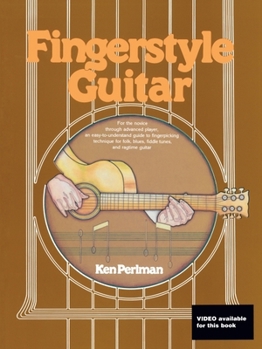Fingerstyle Guitar: Guitar Technique
Select Format
Select Condition 
Book Overview
(Guitar). Teaches beginning or advanced guitarists how to master the basic musical skills of fingerpicking techniques needed to play folk, blues, fiddle tunes or ragtime on guitar. Contents: All the Good Times * Along the Rocky Road to Dublin * Barrow Street Rag * The Beaumont Rag * Behind the Bush in the Garden * Campbell's Farewell to Red Gap * Candy Man * Candy Man Blues * The Cherokee Shuffle * Cranberry Highway * Cripple Creek * Eighth of January * The Entertainer * Fishing Blues * Freight Train * (There'll Be) a Hot Time in the Old Town Tonight * Lark in the Morning * The Lazy Afternoon Blues * Little Sadie * The Liverpool Hornpipe * Lord Inchiquin * Louis Collins * Make Me a Pallet on the Floor * Man of Constant Sorrow * The Manchester Angel * The Mineola Rag * The Morning Blues * Pack up Your Sorrows * Paddy on the Railroad * Payday * Rain Don't Fall on Me No More * Shady Grove * The Sligo River Blues * Spike Driver Blues * Stealin', Stealin' * The Temptation Rag * The Trip to Sligo * Turkey in the Straw * The Year of Jubilo (Kingdom Coming).
Format:Paperback
Language:English
ISBN:157424115X
ISBN13:9781574241150
Release Date:January 2002
Publisher:Centerstream Publications
Length:256 Pages
Weight:1.90 lbs.
Dimensions:0.9" x 8.9" x 11.9"
Customer Reviews
5 ratings
Excellent for beginners
Published by Thriftbooks.com User , 19 years ago
I began fingerstyle with Zeppelin's "Babe I'm gonna Leave You" - learning from a tab, and picked up this book on a friend's rec. It is outstanding, there are a handful of great tabs provided that sound great and are fun to play (ie, "Freight Train"), while learning the basics. A bunch of Mississippi John Hurt tabs are in there, and after 4-6 months anyone should be able to play 'Candyman' with expertise. If you like fingerstyle and don't know Hurt, get his 'Best of' Live at Oberlin on vanguard. Anyway, an outstanding book for any willing player.
Fingerstyle guitar
Published by Thriftbooks.com User , 21 years ago
Ken Perlman packs a gig bag-full of fingerstyle guitar into this book. While it definitely targets novice fingerstyle players, it is not a book for those just beginning to play the guitar. Although Perlman introduces tablature, he assumes the player can read standard notation and already has a good knowledge of the fingerboard. Also, because much of fingerstyle is based on movable chord positions, the student should have some facility negotiating between chords.That said, the book begins by introducing the style of alternating bass and builds increasingly complex melodies and techniques over this basic pattern. The student will learn all the standard left hand techniques (hammer-on and pull-off notes, slides, graced notes, etc.) as well as some development of the right hand. Perlman's approach is to use individual songs to introduce each concept which keeps the learning process musical without being overly didactic. In my view, there are several points that elevate Fingerstyle Guitar above most other instructional books. First, Perlman selects great acoustic guitar music. If you like the simple yet wonderful style of Mississippi John Hurt, it's there within the first few pages. With about 40 songs in all, the blues, roots and Celtic tunes are great fun to play, and much of the credit goes to Perlman's arranging and writing abilities. I also like the way Perlman sets each song up, giving the student some context in regard to the composer, or the song's history. And finally, following each piece, Perlman focuses on specific measures in the song that may be problematic, such as fingering patterns in chord transitions or tricky syncopations.While Fingerstyle Guitar starts from a very basic level, the pace of skill development is brisk. For example, open tunings are introduced barely half-way through the book. The tunes near the end of the book, such as Joplin's "The Entertainer", are definitely for the capable intermediate guitarist. Therefore, I would also recommend the book to anyone who has previous exposure to fingerstyle.For the intermediate-to-advance level player, Perlman's Advanced Fingerstyle Guitar is an excellent companion book which follows the same basic format set-out in Fingerstyle Guitar. Centerstream Publications has done a good job in the clear presentation of text and notation for both books. I particularly like the use of archival photographs of musicians that begin each chapter.Overall, you won't be disappointed with Perlman's approach to Fingerstyle Guitar.
Best book for beginners...
Published by Thriftbooks.com User , 22 years ago
The great thing about this book is that it really shows you how to play fingerstyle guitar. For every exercise and transcription, the author discusses the new technical problems for the piece -- showing you the most efficient way to fret chords, discussing any particulary complicated picking pattern, etc. Songs are presented in tab and in standard notation.Chapters cover everything from basics to hammer-ons, pull-offs, slides, bar chords, celtic and ragtime styles, etc.Along with Perlman's second book, 'Contemporary Fingerstyle Guitar', makes a great introduction to playing fingerstyle.
Great for any level
Published by Thriftbooks.com User , 22 years ago
This book falls into that classic "oldie but goodie" category. Each segment of the lessons builds on its predecessors to make the process gradual and logical. This approach also allows more advanced players to skip to the chapter that is most appropriate for their level. I would recommend this book for anyone trying to learn or improve their fingerpicking skills.
Ken Perlman's "Fingerstyle Guitar"
Published by Thriftbooks.com User , 22 years ago
Ken Perlman's "Fingerstyle Guitar" is the bible of fingerstyle guitar manuals and belongs in every serious guitarist's instructional collection. I insist that my students use this book as a fingerpicking guide.





